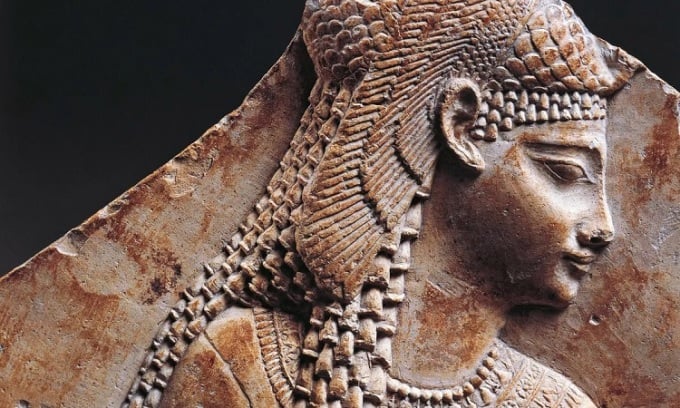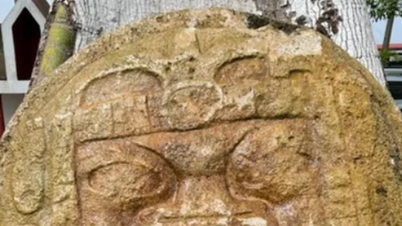Egypt Researchers still cannot agree on the physical characteristics of Queen Cleopatra because her remains have not been found and there is no information about her biological mother.

A relief depicting Queen Cleopatra. Photo: De Agostini
Cleopatra VII may be the most famous woman in the ancient world . She was the last ruler of the dynasty that ruled ancient Egypt for about 300 years, from the death of Alexander the Great to the rise of the Roman Empire. Her face has been immortalized in numerous artifacts, including coins. Perhaps the best-known portrait of Cleopatra is a relief in the Egyptian temple of Dendera, along with her son Caesarion, according to Live Science .
Yet, researchers still know very little about what the most powerful woman in the ancient world looked like. In recent years, controversy has centered on Cleopatra's skin color. Archaeological records offer few clues. Her remains have never been found. Contemporary illustrations do not accurately depict the queen's appearance. "We have no evidence from antiquity that can reveal Cleopatra's skin color," says Prudence Jones, a professor of anthropology and classics at Montclair University. Moreover, our concept of "white" or "black" skin color was foreign to the ancients.
Queen Cleopatra VII reigned from 51 to 30 BC. She was the last ruler of the Ptolemaic dynasty, which ruled Egypt for nearly 300 years. When Julius Caesar visited Egypt, she had a son with him, Caesarion. Cleopatra later became the lover of Mark Antony and bore him three children. After Octavian's forces invaded Egypt in 30 BC, Cleopatra committed suicide.
There are not many artifacts of Cleopatra that researchers have found, including coins at the Taposiris Magna site in Egypt. In addition, there are many statues depicting Queen Cleopatra in museums around the world. However, researchers are not sure about the origin of the statues and whether they really depict Queen Cleopatra.
Andrew Kenrick, a visiting researcher at the University of East Anglia in England, said ancient writers often left out what their figures looked like. Statues can also be misleading because they tend to exaggerate a figure’s appearance rather than its true form. For example, a sculpture might depict a king who was larger than he actually was.
Additionally, scientists do not know the identities of Cleopatra's mother or grandmother, meaning the queen may have had African ancestry. They only know that Cleopatra's father was Greek. Ptolemies sometimes married directly, and Cleopatra married her brother, Ptolemy XIV, before he was killed in 44 BC.
However, Zahi Hawass, former Minister of Antiquities, said that her Greek origins clearly show that Cleopatra was not black. Historical documents show that she was a descendant of a general in Macedonia, Greece, who was a contemporary of Alexander the Great. Cleopatra's language was Greek and in busts, she is depicted with white skin.
In 2009, researchers examining remains found in a tomb in Ephesus in modern-day Türkiye in 1926 said they believed the skeleton belonged to Arsinoë IV, Cleopatra's sister who was murdered on Mark Antony's orders in 41 BC. According to ancient records, Cleopatra suspected Arsinoë of trying to usurp her throne.
Although the skull was lost during World War II, the team reconstructed and analyzed it using old photographs and drawings. They identified cranial features that indicated Arsinoë IV’s mother was of African descent. The distance from the forehead to the back of the skull was very large compared to the height of the skull, which is common in many black African groups. That means Arsinoë IV was of mixed descent, according to Caroline Wilkinson, professor of anthropology at the University of Liverpool.
Assuming Arsinoë was Cleopatra’s sister, the queen could have had African ancestry. But Duane Roller, professor emeritus of classics at Ohio University, argues that it is unlikely that Cleopatra and Arsinoë were half-sisters, as Cleopatra’s father, Ptolemy XII, fathered children with several women.
An Khang (According to Live Science )
Source link





![[Photo] Prime Minister Pham Minh Chinh receives Lao Minister of Labor and Welfare Phosay Sayasone](https://vphoto.vietnam.vn/thumb/1200x675/vietnam/resource/IMAGE/2025/11/11/1762872028311_dsc-2246-jpg.webp)
























































































![[Motion Graphics] How to submit red book on VNeID](https://vphoto.vietnam.vn/thumb/402x226/vietnam/resource/IMAGE/2025/11/12/1762909837040_fb_thum-web-bht-1.jpeg)









![Dong Nai OCOP transition: [Article 3] Linking tourism with OCOP product consumption](https://vphoto.vietnam.vn/thumb/402x226/vietnam/resource/IMAGE/2025/11/10/1762739199309_1324-2740-7_n-162543_981.jpeg)








Comment (0)